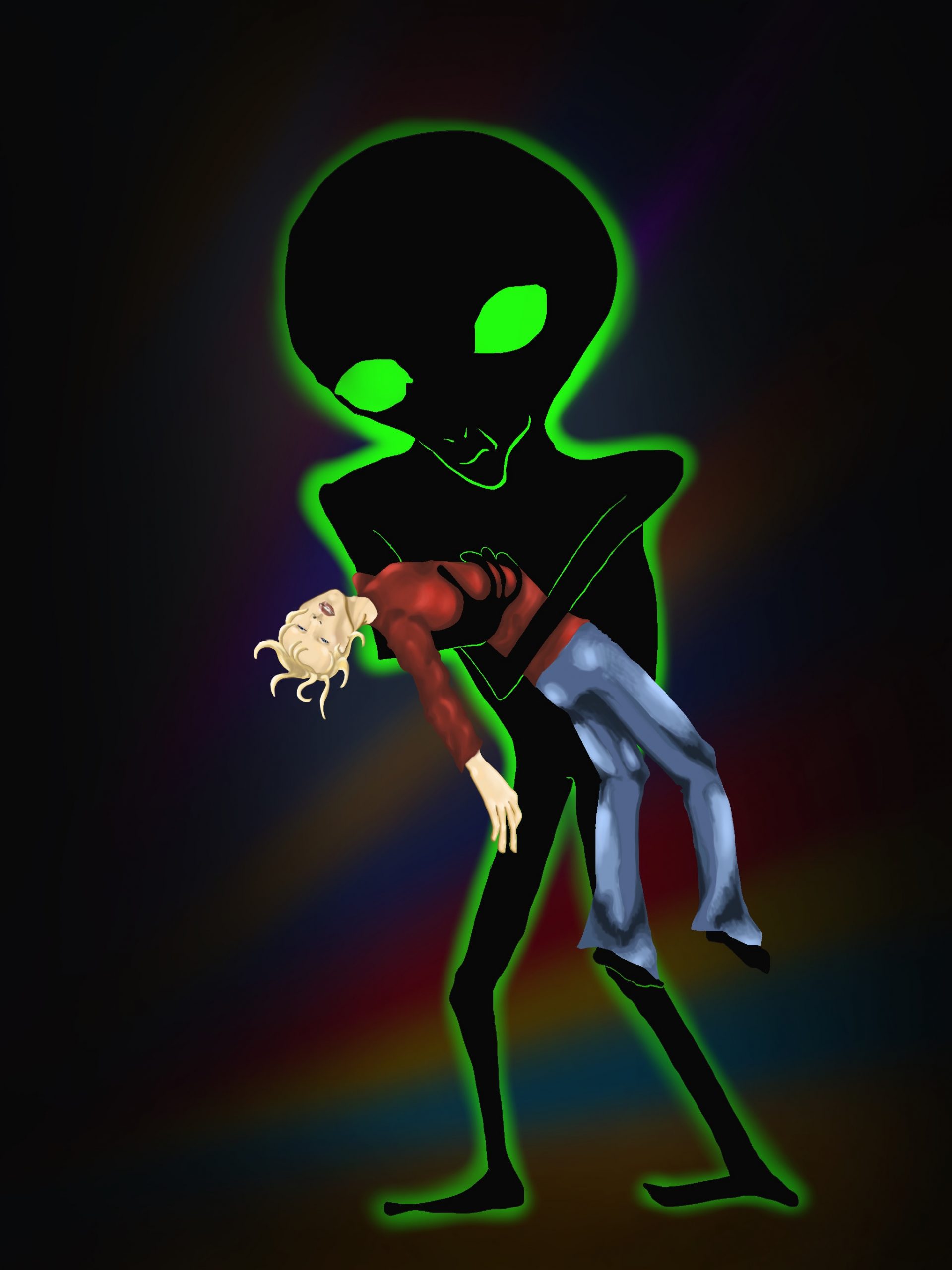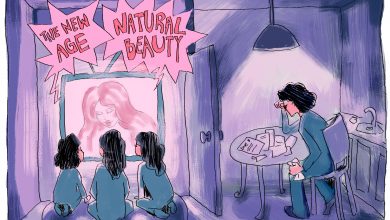Space Lasers and the Death of Imagination

Image Description: An alien outlined in bright neon green grasps a human figure with blonde hair wearing a long sleeve red shirt and blue denim jeans.
Design by Coral Utnehmer
There’s something cathartic about a bad movie. For me, no movie hits the sweet spot of formulaic yet interesting enough to enjoy quite like “Independence Day.” It has all you could want: Will Smith, yada-yada science, and a giant laser blowing up monuments. It also, not so coincidentally, proudly features the U.S. military defending the country from a foreign invasion. “Independence Day: Resurgence” even partnered with the U.S. army to boost recruitment efforts.
It’s not just “Independence Day.” The world of B-Rate sci-fi movies, like many others, is ripe with overused tropes, but it’s one of the few genres that seems to be almost completely defined by them. Replace the aliens in “Independence Day” with a hurricane and it’s a disaster movie, replace them with a foreign country’s military and you get “Top Gun.” Science fiction has been increasingly defined not by the content of media, but by the aesthetics of it.
One reason tired tropes like alien invasions, malfunctioning robots, and mad scientists keep getting rehashed is because the genre itself is very exclusive. Science fiction is often considered a more ‘prestigious’ type of fiction, a prestige which extends to the authors who write in the genre. Unlike fantasy or literary fiction, it is supposedly grounded in ‘real science.’ Books like “The Martian” gained some popularity from being scientifically accurate, and many debates have been had over what counts as ‘hard’ vs ‘soft’ science fiction.
In addition, sci-fi often gets more publicity, draws in more people, and creates more fan interaction than other genres of fiction, all of which encourage authors to want to have their work seen as sci-fi. This means that it’s often a battle to get a book classified as science fiction rather than fantasy, since quantifying how real fictional science is can be very difficult. One easy way to be considered as science fiction, however, is to use popular tropes your audience will associate with the genre.
But why is the invasion plot so popular? Well, “Independence Day” isn’t just about the aliens—remember the partnership with the army? By showing the U.S. military strongly defending the homeland from alien invaders, many alien invasion movies draw a parallel to how the U.S. would defend itself from real potential invasions from foreign nations. This then encourages viewers to support more military spending and enlistment. Intentionally or not, the movie acts as military propaganda. It also serves as an ad for the MacBook, if you look close enough.
This act of increased military enlistment and spending helps continue America’s colonial efforts. The U.S. has military bases across the globe, most of which act as a subliminal threat to the country they’re placed in, emphasizing the ease with which the American military can attack should the country’s leaders go against U.S. policies or interests. Even if military bases provide no direct threat, they’re often the source of hostile interactions between the occupying force and the host country, contributing to an increase in sexual violence, environmental pollution, and economic changes.
This isn’t new. Science fiction and colonialism have stood hand-in-hand since the beginning of the genre. Many ‘classic’ sci-fi authors, from H.G Wells to George Lucas, apparently can’t help but envision a world in which Earth is being invaded. This makes sense for Wells⸺War of the Worlds was written at the turn of the 20th century, the height of England’s settler colonial expansion. Wells’ novel essentially flips the colonial project onto Britain instead. The novel opens with a direct comparison of the fictional Martian invasion he describes to England’s very real colonization and genocide of Tasmania.
From Wells’ point of view, European countries were able to colonize foreign nations because of ‘technological superiority,’ and so he devised a thought experiment about a foreign invader that is able to colonize England through superior technology in order to call into question the morality of colonizing a foreign country. Thus, the alien invasion plot was born. Today, we see it in the form of movies like “The Tomorrow War,” “The Fifth Wave,” and “Arrival” among many others which feature the U.S. army, guns blazing, defending the world against invading aliens.
It’s not just the alien-invasion-to-colonialism metaphor that gets reused. One of the best examples of a science fiction trope that relies on racist and colonialist themes is the cyberpunk aesthetic. If you’ve never heard of it before, cyberpunk is a subgenre of sci-fi categorized by a dystopian but technologically advanced society, often mixing grunge aesthetics with futuristic ones. Think robotic rats, nanotech drugs, and skyscrapers designed to look like pagodas.
Cyberpunk aesthetics often feature East Asian influences while simultaneously dehumanizing Asion people. “Blade Runner 2049”, for example, features Japanese kanji on neon signs, a Chinatown, and bento boxes, but includes no Asian characters with speaking roles. When Asian characters are featured, they’re often relegated to the role of cyborgs or robots, playing on racist stereotypes and further dehumanizing them.
Similar to the alien-invasion-as-colonialism metaphor, techno-orientalist aesthetics have historic roots. As opposed to the colonialism subtext in alien invasion movies, techno-orientalist aesthetics have roots in WWII-era fears of Japan becoming technologically superior to the U.S. and Europe. Today, the tropes have the same xenophobia embedded in them, evolving to portray many East Asian countries as a threat to U.S supremacy. Whether it be the seeming threat of China’s economic power or North Korea’s nukes, the punchline remains the same⸺the U.S is in danger, and the future is both bleak and Asian.
So, why is a genre focused on the future so outdated? Science fiction stories are both products of their time and their authors, but often reinforce stereotypes that are present today. Historically, the majority of what we consider ‘classic’ science fiction novels were written by well-educated, straight white men. When given the ability to occupy a space where they are given agency, many of these authors didn’t have to look at current societal issues their counterparts faced like racism, homophobia, or sexism, and instead were able to abstract their problems into other universes, essentially imagining a world in which they’re oppressed. Oftentimes this comes in the form of dystopian fiction about what would happen if we adopted politics they don’t agree with—“Brave New World” that explores the consequences of communism, “War of the Worlds” explores the consequences of colonialism, and “Independence Day” explores the consequences of not funding more tanks.
Along with this, many early feminist science fiction works explored what an all-women utopia would look like, usually with the moral being that men are the root of all problems in society today. These lie on the flipside of the ‘imaginary oppression’ coin, with predominantly white, straight, and cis women narrowing societal problems down to the view of ‘girls rule, boys drool.’ While these works obviously face a similar issue of being reductive and exclusionary, they also have a slightly more insidious edge of presenting a solution to the problem that’s exclusive to the privileged women who wrote them.
Obviously sexism was, and still is, a large issue many femme-presenting people face, however by framing the solution to sexism as being as simple as getting rid of men you put on blinders to the ways in which other systems of oppression homophobia, transphobia, capitalism and racism all amplify the effects of sexism and create problems outside of it. Even worse, you ignore the fact that many of these oppressive systems are upheld not just by the men these utopias exclude, but by the women that would run it. These utopias also inherently contribute to gender-essentialist thinking, defining gender as a binary and biological, something inherent to a person that cannot be changed or learned. This ignores how men are affected by oppressive systems and patriarchal values, not just women. It’s also pretty much the definition of TERF-dom, inherently excluding trans and non-binary people by narrowly defining a ‘woman’ and not including anyone who doesn’t fit that mold.
When science fiction is so busy trying to prove itself as science, it cuts out room for the fiction and the creativity that goes into the genre. First on the chopping block are books typically written by authors that don’t fit the historic mold. A report by the “Fireside Fiction” magazine found that in 2015, out of 2,039 science fiction stories studied, only 38 were written by Black authors—that’s under 2%. When sci-fi written by Black authors gets published, it’s also often only included in special race-based issues of a magazine or seen as social commentary, genres which get less publicity from the magazine and often aren’t as commercially profitable as science fiction.
Authors who publish under a feminine-sounding name, while making up the majority of writers overall, are still typically underrepresented in the science fiction genre. This isn’t for a lack of interest, but rather because of the genre’s exclusive nature. Many books that fit into the sci-fi genre get labeled as fantasy or young adult fiction if they’re geared towards women.
“The Hunger Games,” for example, is a novel about a teenage girl in dystopian America fighting against oppressive and capitalist forces. Although it fits into both the young adult and science fiction genres, it’s typically seen as young adult fiction. “Red Rising” is a book about a teenage boy fighting against oppressive and capitalist forces on Mars. It also fits into both genres (and includes romance, just like “The Hunger Games”), but is commonly described as science fiction. The main difference? “The Hunger Games” features a female protagonist and author, while “Red Rising” has a male protagonist and author.
This disparity denies these books and authors the publicity and prestige of being published under sci-fi, as well as discourages new readers who can’t see themselves in the typically white, typically male main characters of many sci-fi books. This also means readers often don’t experience stories from the perspective of marginalized people, instead reading about a fantasy world in which oppressors are marginalized. Fiction stories often help us develop empathy and understanding, and leaving these stories out of the genre limits the reach of literature that could develop understanding for social issues that affect marginalized people today.
Sci-fi is one of the few popular genres that provides an easy way (and practically demands) for authors to say something relevant about society today. As a result, it can provide some of the most interesting intrapersonal and geopolitical commentary within the vehicle of a fiction book. This isn’t to say that current sci-fi media does not challenge these norms—”Everything Everywhere All at Once,” “Nope” and “Severance” all utilize sci-fi elements to uniquely explore our relationship to the people around us and the universe we live in. Authors like N.K. Jemisin and Octavia Butler have published multitudes of work on the nature of humanity and how intersections of race, gender and class affect both individuals and larger society. It’s important that stories like these don’t get lost in the ever-expanding sea of guns, aliens and larger-than-life space lasers. In a universe where we can imagine anything, why not try to imagine something better?




